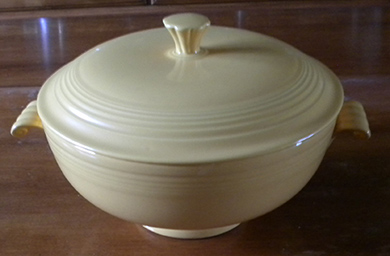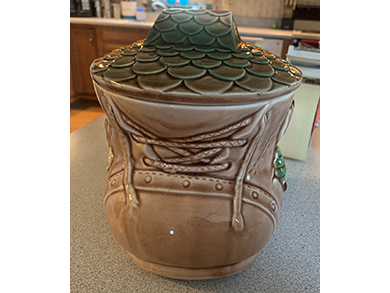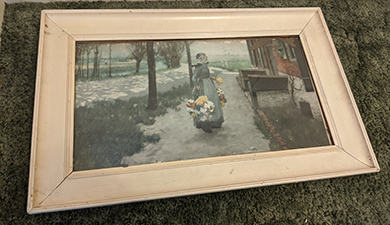 |
|
|||
 |
 |
|||
RINKER ON COLLECTIBLES — Column #1773 Copyright © Harry Rinker, LLC 2021 Questions
and Answers
QUESTION: My mother has a large collection of Fiesta ware that she acquired when she married my father in 1946. The Fiesta logo on the back of the pieces begins with a lower case “f,” which is an indication the pieces are from the earlier issue of Fiesta. A list of pieces includes bread and butter plates (8), 7 inch cereal bowls (4 – 2 chipped), celery trays (3), cups (10 – one chipped), covered casserole, egg cups (2 – 1 chipped), fruit/dessert bowls (4), gravy boat, meat platter, 6 1/2-inch plates, 9 1/2 inch plates (10), saucers (3 – one chipped), sectional dinner plates (4), serving bowls (2), shaker, pepper (1), shaker, salt (1), 7 1/2 inch soup bowls (4), and sugar bowl and creamer. A selection of .jpg images of the collection and individual pieces accompany my email. My mother wants to dispose of the collection. What is your advice? – EK, Altoona, PA, Email Question 
ANSWER: When evaluating any dinnerware collection, I ask two basic questions. The first is how many five-piece place settings (cup and saucer, bread plate, salad plate, and dinner plate) are possible. The cups are the limiting factor in your mother’s collection, especially since cup one must be discounted because of its condition. The total number of five-piece place settings is two, thus removing place settings as a selling value. The second is how many serving pieces are there. In most dinnerware services, the value is in the serving pieces. Pieces such as coffeepots and tureens were produced in much smaller quantities. Many individuals did not acquire them. They are missing from the list that you sent me. In respect to your list, the critical question is the identity of the covered casserole. If it is the “covered onion soup” serving bowl, then this one piece represents almost 75 per cent of the collection’s value. The pictures that accompanied your email were a help in evaluating the collection. They also told me that additional information is needed before a complete evaluation is possible. The Homer Laughlin China Company introduced Fiesta, the creation of Frederick Hurten Rhead, at the January, 1936 Pittsburgh China & Glass Show. The first five colors were cobalt blue, green, ivory, red, and yellow. A year later, turquoise was added to the color line. New colors and forms were added continually. Form and color are critical to value. Contact the interlibrary loan person at your local library and ask her to borrow a copy of Bob and Susan Huxfords’ “Collecting Encyclopedia of Fiesta Ware, 10th Edition,” published by Collector Books in 2005, for you. Forget the prices. They are no longer valid. Use the book to identify the exact forms and colors in your mother’s collection. As I indicated earlier, the key is the “covered casserole.” If it is the “covered onion soup” server and its color is old ivory (not white), its sell through value is between $500.00 and $600.00. If is not the “covered onion soup” server and is different color, its value is greatly decreased. It also appears some of the other forms on your list are misidentified. Consider spending $45.00 to join the Homer Laughlin’s China Collecting Club. The club publishes a directory of its members, ideal for locating collectors and dealers living near you. It also allows members to advertise for free in its newsletter. Sell the collection as a whole – take it all or not at all. Do not allow anyone to skim off the better pieces. As always, the less asked, the quicker the collection will sell. If the covered casserole is the “covered onion soup” server, use a starting price for the collection of $850.00. If the covered casserole is simply a covered casserole, start at $300.00. Be prepared to negotiate. There are approximately 60 pieces in the collection, discounting the damaged good. At $300.00, this is an average price of $5.00 each, far below book value and sell through prices for the many of the forms and colors on WorthPoint.com. My suspicion is that neither you nor your mother wants to become a dealer and piece out the collection over time. When the advertising costs, labor, and other overhead expense are deducted from money received, you will find the final cost to sell will be far less than $5.00 per piece, revising the old adage - money in hand is worth more than money hoped. QUESTION: I am trying to locate information on a cookie jar that I found in my mother’s basement. It is shaped like a boot with laces in the front. The top is a petal roof with a tapered round handle in the center. The back has a bold, colorful floral motif. The mark on the bottom is a three-leaf clover surrounded by a wreath. “JAPAN” appears below the wreath. Is it worth anything? – BW, Email Question 
ANSWER: Thanks for including a photograph of the mark among the images of the cookie jar that accompanied your email. Using the image, I was able to identify the mark as that of the Nippon (Nihon) Yoko Boeki Co. Reference sources describe the mark as “wreath with a bow at the bottom and a clover.” The mark is found in black, as on your cookie jar, and dark green. The only information I found about the company was that it was founded in 1895 and still is in business. Multiple searches of boot-shaped cookie jars on eBay, WorthPoint.com, and other internet sites did not provide a matching image for your cookie jar. Do not jump to the conclusion this means the cookie jar is scarce. Sellers do not list objects for which there is no market. More likely than not, it means there is little to no collector interest in the jar. When former listings fail to sell through, sellers usually get the message and stop listing examples. Your cookie jar dates from the mid-1950s to the mid-1960s. It most likely was made for an American wholesaler who jobbed it to discount stores and Big Box stories. Collectors collect what they know. When a cookie jar appears on the secondary market that is not pictured in one of the many cookie jar price guides published in the 1980s and 1990s, collectors shy away from purchasing it. Although in great condition, the Nippon (Nihon) Yoko Boeki Co. boot-shaped cookie jar has a secondary market value of $15.00 to $20.00. Its real value is to fill it with homemade cookies and allow your family and others to enjoy opening the lid, selecting a cookie or two or three, and eating them. QUESTION: I have a matted and framed print of George Hitchcock’s “Flower Girl in Holland.” On the back is a paper label for “Henry Graves & Company, Limited / Dealers in Works of Art, Printsellers [sic.], Framemakers [sic.], Restorers, and Publishers / 44 Cherry Street, Birmingham / London and Paris.” How much might this be worth? – CP, United Kingdom 
ANSWER: A reproduction print of a famous painting is exactly what the name implies – a reproduction. Chances are there were hundreds, if not thousands, of copies made when the print was on the press. As a result, the print itself has little value. In addition, the subject matter of the print is out of vogue. There is little decorating interest in the subject among younger adults. This is as true in England as it is in the United States. The label on the reverse adds no value to the framed print, with the possible exception of interest by a local Birmingham collector. The only value is the frame, and it appears to be a stock, standard rather than specially made frame. Provided a buyer can be found, a reasonable secondary retail market value is between $10.00 and $15.00. Postscript: George Hitchcock (1850-1913) was an American painter who studied in London, Paris, and the Hague. He worked for 20 years in Holland. “The Flower Girl in Holland,” the subject of the print, was painted in 1887. It is part of the painting collection of the Art Institute of Chicago. QUESTION: I have a kneehole desk with one drawer on each side of the knee hole. The metal label reads: “PAINE FURNITURE COMPANY / BOSTON, MASS.” It is not in the best of condition. Should I paint it or restore it? – V, Email Question ANSWER: Feel free to do whatever you like to the piece. The desk is a mass-produced piece of furniture. The Paine Furniture Company produced middle quality furniture. The company’s furniture is not found in art museum collections. Before spending money to have the piece refinished, try one of the wood finish restorers such as Restor-A-Finish by Howard. If you are satisfied with the results, stop and go no further. If you decide to paint it, know that the desk will have no resale value once you do. Whatever you do will result in your using the desk – good news, indeed! Harry L. Rinker welcomes questions from readers about
collectibles, those mass-produced items from the twentieth and twenty-first centuries.
Selected letters will be answered in this column.
Harry cannot provide personal answers.
Photos and other material submitted cannot be
returned.
Send your questions to: Rinker on Collectibles, 5955 Mill
Point Court SE, Kentwood, MI 49512.
You also can e-mail your questions to
harrylrinker@aol.com.
Only e-mails containing a full name and mailing address
will be considered.
|
||||